| |||||||
| Search Forums |
| Advanced Search |
| Go to Page... |
 |
| Search this Thread |  11,303 views |
| | #1 | ||
| Distinguished - BHPian  | England in a nutshell | Rolling hills, castles and helicopters! This travel story has three parts. The first part is all about us getting to and driving around the UK and ending up in Bath. The third part is about us driving back from Bath via Suffolk. The second part is about my visit to a magnificent helicopter museum near Bath. Feel free to read it all, or skip the parts you are not interested in. Enjoy!! Jeroen So it begins: My wife and I had a very busy summer for various reasons. A very large part of our friends and family live abroad. This was the first summer after the pandemic everybody could travel again. So we had a lot of family and friends staying with us. Also, our eldest son Luc got married to his partner of many years Maloeke. Just as my wife she grew up in the Caribbean, though a different island from my wife’s. But again more people to see, meet and host in our house. So in all, a very nice time. But we felt we needed a break. We decided to spend some time in the UK. We had some other friends we would like to see. We always enjoy touring around the UK. Until Brexit we had some properties in Suffolk, one being our little holiday home. We sold them, so no fixed place to stay. Nowadays, we rely on friends, families, hotels and B&Bs to put us up. When travelling from the Netherlands to the UK by car there are different options. It does depend a bit where you need to be in the UK. But as long as you are not going far north our preferred method is taking the Stenaline night ferry from Hook of Holland to Harwich. We have taken this crossing dozens, if not hundreds of times. We can still have dinner at home, leave at about 19.15 and rock up to the ferry terminal in Hook of Holland at around 20.00 hours. Boarding is usually very quick, which means we get to spend some time on board, have a drink in the bar. For these sort of trips there can only be one car from our little family fleet: My gorgeous Jaguar XJR! Here we are, parked at the terminal, passed check in and immigration, waiting to be allowed to drive onto the ferry.  As luck would have it, spanner mate Peter and his son Marco rocked up as well, in Peter’s gorgeous 1980 Alfa Romeo Spider Coda Tronca! They were on their way to the Goodwood Festival.  It was by pure chance we found ourselves on the same ferry. Peter and I only found out about a week earlier. So we drove onto the ferry and the four of us had a very enjoyable evening, drinking and eating in the bar. If you cross on the night ferry, it is mandatory to take a cabin as well. In the past we used to take a two person inboard cabin. Very simple, perfectly adequate, but it is always a bunk bed. Although I consider myself to pretty fit and in good shape for a guy my age, I just don’t like having to climb up a ladder to go to sleep. You only live once and you can’t take it with you, so these days we get ourselves a much roomier outboard cabin with proper beds without ladders!  Actually, we got a little upgrade from Stena, as this was even a slightly more luxurious cabin than we reserved. It came with its own little free minibar! We immediately looted the mini bar, took also all the complimentary chips and chocolate bars and installed us in the bar on the main deck, waiting for Peter and Marco to join us. Weather was very nice, so apart from a bit of vibration now and then you don’t even notice you are on a boat. The ferry dock at Harwich at around 05.00AM, local time. They wake you up around 05.30 (which is actually 06.30 Dutch time). By 06.30 local time unloading will start. When we still had our holidayhome we never breakfasted on board, we just drove home and we would be in our own home by 07.30. These days we always have the breakfast option as well. You get a decent enough full English breakfast plus lots of other food and drinks available. From croissants to yoghurts. We said our goodbyes to Peter and Marco as we would be making our own separate ways. By about 07.45 we passed immigration and customs and were on our way heading south. Our first stop was with friends living in a tiny village near Colchester. We arrived around 09.00. We had to drop off some of their stuff that for various reason had been left in our home in the Netherlands. From there we made our way to Horsham. Horsham is about 10 miles south west of Gatwick. We made very good time down the motorways, across the Dartford Crossing and along the M25. If you even find yourself going across the Dartford Crossing note you need to pay toll. There are no toll booths. You have to go online to make the payment. You are allowed to make the payment before midnight the day after you made the crossing. https://www.gov.uk/pay-dartford-crossing-charge Going north you will be going through a tunnel and going south it is a bridge. Gorgeous views along the way.  We reached our friends home in Horsham by about 11.30 with only one coffee stop in between on the M25. Look for the big service areas where you will have petrol stations, but also shops like WHS, Starbucks etc. We stayed for lunch and moved on. We drove to friends, Wendy and Graham of ours in Poundbury, next to Dorchester. Wendy and Graham stayed in India during the same years as we did. They also lived in Delhi. We met them on one of many travels. Since that first meeting the four of us have travelled to many places in India together. And when all of us moved back to Europe we kept travelling together. Again, due to the pandemic, no travelling or even meeting up. So we were staying two nights with them to catch up and do some sight seeing in this part of the country. We drove along some country and coastal roads to finally make it to Poundbury by the end of the afternoon.  We had never been to Poundbury, but have heard about it. It was one of (then still) Prince Charles pet project to build more attractive homes. I did not take any photographs, but have a look here: https://poundbury.co.uk Quote:
We thought it all a bit weird. Although apparently more younger families are moving in, a lot of more “mature” people live there. The next day Wendy and Graham took us for a nice walk along one of the RPSB estates. (https://www.rspb.org.uk) We ended up on the waterfront. 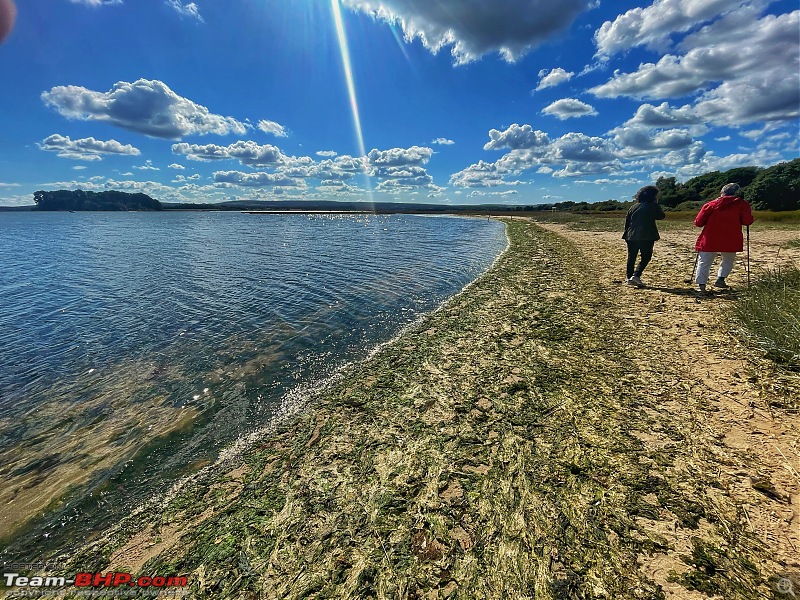  Next we drove across some gorgeous country roads to Corfe Castle. I had never even heard of Corfe Castle. Turns out is one of the biggest castles in the country. 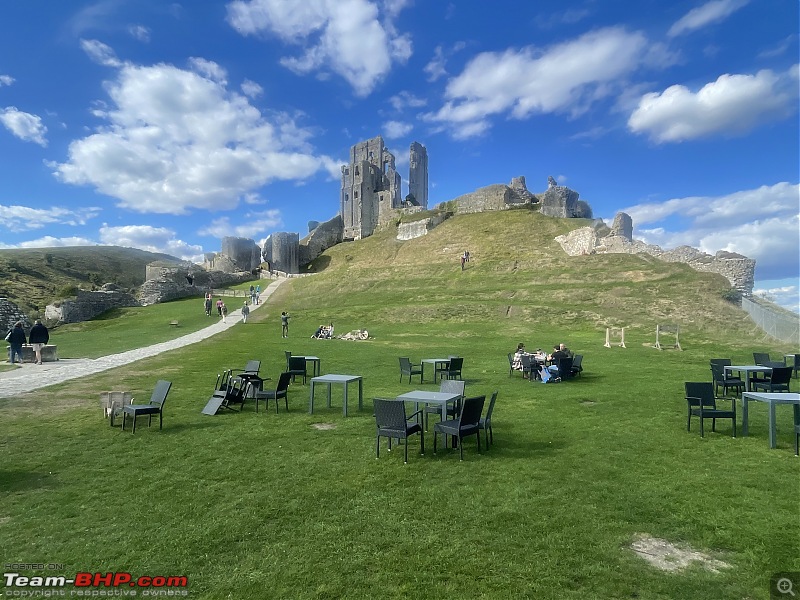  It is more than a thousand years old! In 1074, William the Conqueror exchanged a church in Gillingham for the castle hill and land around it owned by the then Abbess of Shaftesbury.  The first stone of Corfe castle was laid in 1086 and since it has been extended. It has been a treasury, military garrison, royal residence and family home. It was destroyed in 1646 by the Parliamentarians. These days it is run by the National Trust, who as usual, do a fantastic job of keeping the British heritage alive. It’s quite the walk from the car park all the way up to the top of the castle. Time to catch our breath.  Gorgeous view of Dorset from the castle 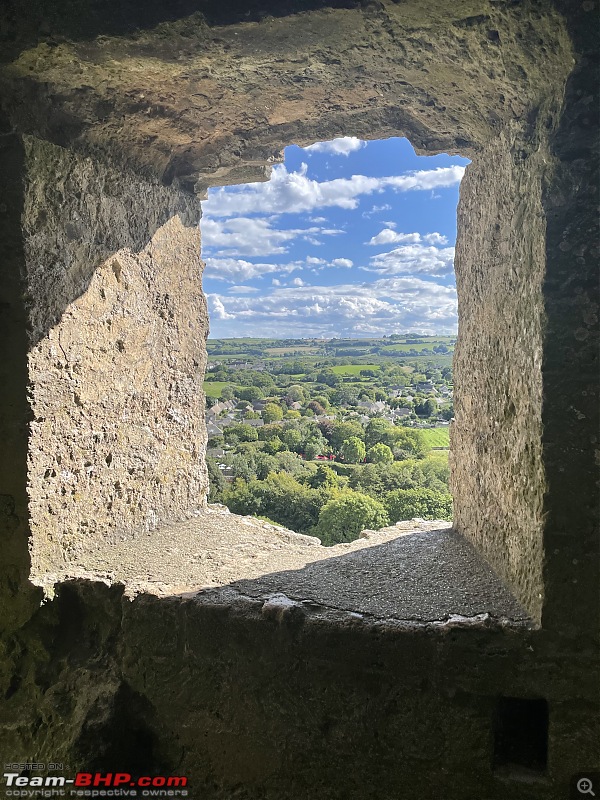  View from the village.  That evening we have a fabulous meal in one of Poundbury’s restaurant. The next morning we set off again to meet some friends in Sidmouth. A very nice little seaside town. Sorry no photographs. It took a very long time to find a parking place there. It was very very busy. One of the reasons being a classic car show held at the cricket club. We just met up with our friends, had a nice healthy lunch and moved on to Bath. We know Bath very well. My wife is a very keen “period dress maker”. Every year the Jane Austin festival is held in Bath. My wife, daughter, son and law and various friends dress up in self made Jane Austin Period dress and parade all day long in Bath. This year the festival was about to end at the weekend we arrive. My wife still wanted to go see some museums in Bath. So we booked a hotel and by end of the afternoon we found ourselves in Bath. Bath is a lovely town, with lots to see and do. Some very nice architecture as well.   Here a so called “long boat” on one of the canals. You can rent them, great fun to travel across the old canals of England.  There are several interesting museums nearby Bath as well. One being the Haynes car museum (https://haynesmuseumshop.org) and the Royal Fleet air Arm Museum (https://www.fleetairarm.com). I visited this some years ago, have a look here: https://www.team-bhp.com/forum/comme...museum-uk.html (Royal Navy Fleet Air Arm Museum, UK) From Wikipedia: Quote:
But as the saying goes, When in Bath, do as the Romans did and have a Thai dinner.  Due to the Jane Austin festival and also because of a Rugby match that weekend it was difficult to find a hotel. I ended up booking a travel lodge for a ridiculous amount of money. Even at that price, no breakfast. But when we are in Bath we tend to have our breakfast in one of the many lovely breakfast cafe’s. This one is our favourite and was only 150 m from our hotel. 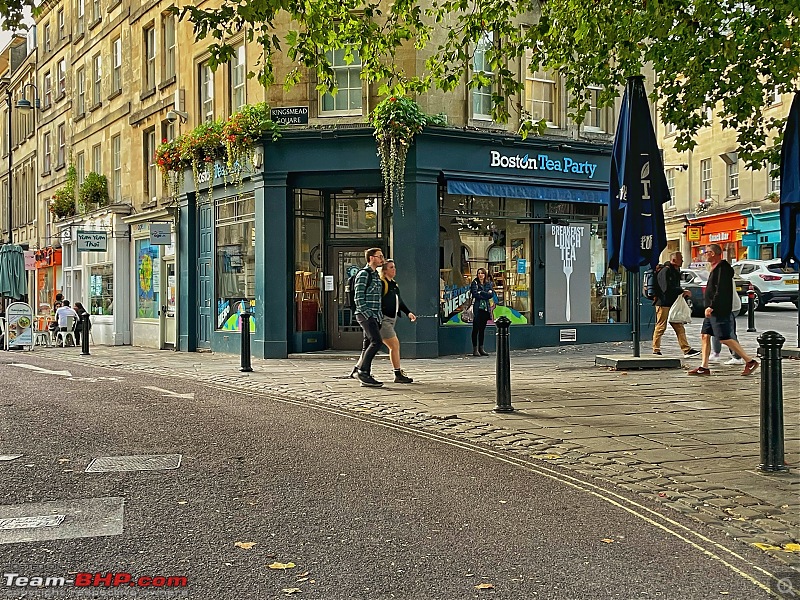 Now this is a proper breakfast for two!!  Some more strolling around:  As we walked around Bath I noticed these Haynes manuals in a bookshop. Haynes is of course very much known for their car workshop manuals. I have quite a few of them. They have also a series about planes, e.g. Concorde, which I also have. But these look like they might come in handy for a few other hobbies/interests!. 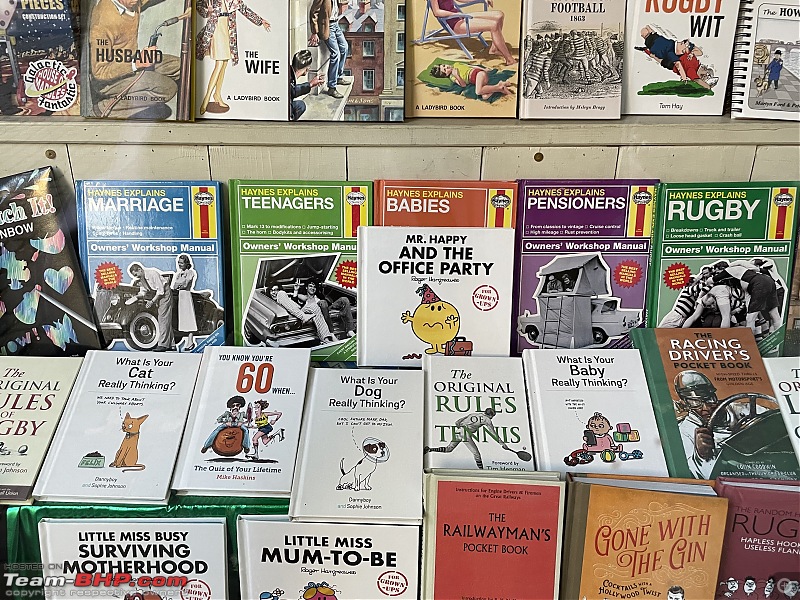 Apart from the Jane Austin festival winding down, the town being full of rugby fans, there was also a marathon on the Sunday. My wife wanted to spend the whole day doing her thing, museums and shops. I needed to amuse myself for the day as well. Somewhere along the way I had picked up this leaflet: 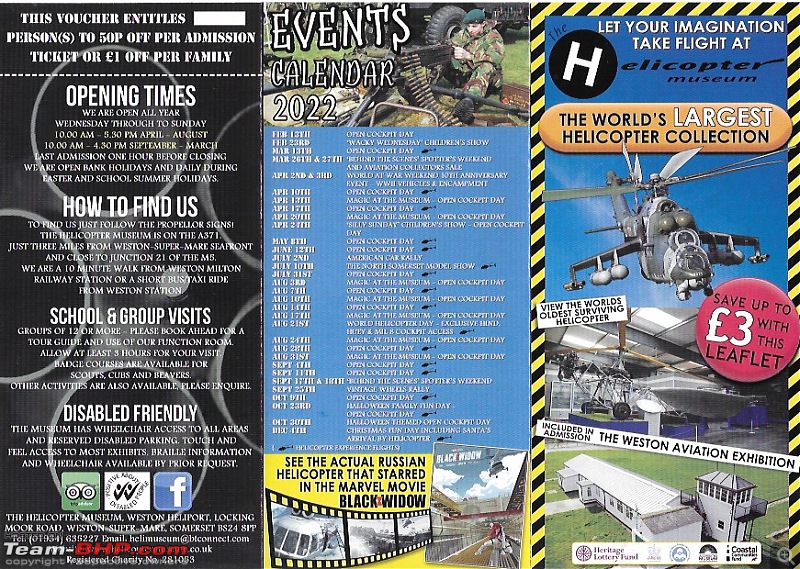 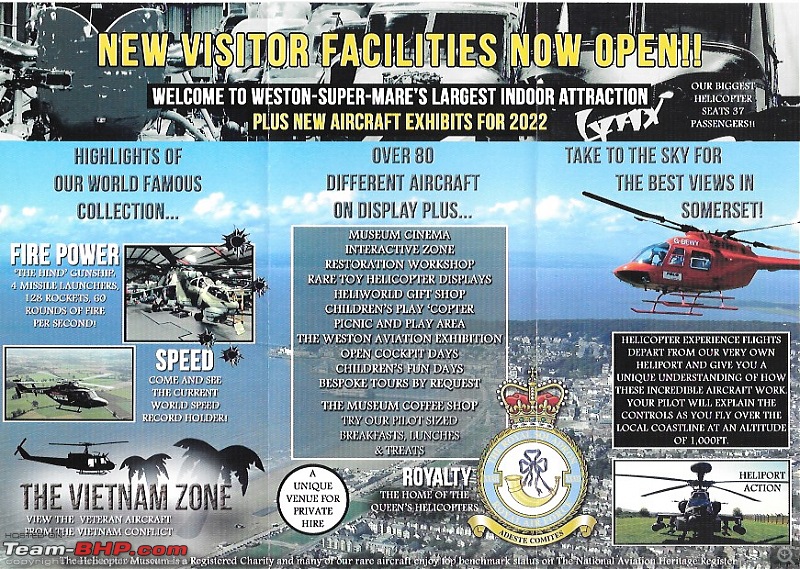 We have been coming to Bath for many years. But I never heard of this Helicopter museum before. Because of the marathon all car parks were closed from 08.00am till 15.00 that Sunday. So I decided to take the train and a bit of walking. The Helicopter museum is on the outskirts of Weston Super Mare. Took about an hour by train and a 15 minutes walk. Very pleasant. The museum was also a huge surprise as you will see! Jeroen Last edited by Jeroen : 26th September 2022 at 23:48. | ||
| |  (47)
Thanks (47)
Thanks
 |
| The following 47 BHPians Thank Jeroen for this useful post: | akbaree, ampere, BrokenHW, carthick1000, clement.lloyd, cooldip, CosmicWizard, dkaile, Dry Ice, Gansan, GaryTSI, GForceEnjoyer, GTO, haisaikat, IcarusMan, iliketurtles, InControl, Karthik.guru, lejhoom, libranof1987, manson, Nair.V8, naveen.raju, NFS_WAYNE, nitinkbhaskar, Omkar, PearlJam, promit, rajesh1868, Ravi Parwan, Rehaan, Reinhard, rj22, ruzbehxyz, sainyamk95, Sayan, spdfreak, swoosh, The Rationalist, vb-saan, vibbs, vigsom, Vinod_nair, vinya_jag, Vishal.R, whitewing, ysjoy |
| |
| | #2 | |
| Distinguished - BHPian  | re: England in a nutshell | Rolling hills, castles and helicopters! Warning!! If you are not interested in helicopters you need to scroll down quite a bit to pick up the rest of our travels. Boy, there were a lot of helicopters! It claims to be the largest dedicated helicopter museum in the world! http://www.helicoptermuseum.co.uk I have been raking my brain, but I don’t think on all my travels around the world I have ever visited a dedicated helicopter museum. Loads of aviation museums around the world. And you will always find a couple of helicopters stashed away in some corner, hidden from the main attraction, planes! Even after reading the leaflet and visiting their website I was not expecting this many helicopters. I have flown quite a bit on helicopters during my offshore days. Also, when we lived in Brighton, UK in the early 80s I had a few hours of helicopter flying instruction. At the time there was a helicopter school in Shoreham. It was incredibly difficult. As a passenger on these choppers I have had the pleasure of riding up front next to the pilot several times. My most memorable ride was when I was picked up from a drilling vessel of the coast of Somalia. The helicopter was a Huey, very similar to the ones used in Vietnam. Just a slightly later version. The pilot was a Vietnam veteran. Cowboy boots, jeans, T-shirt, Stetson hat on his head and a cigar stomp in his mouth. But I watched him fly this thing for three hours. We had a very difficult approach into Mogadishu airport, with almost a mid air collision, due to ATC problems. I have my flying license and I would still like to learn to fly a helicopter, but it is unlikely to happen now. Flying helicopters is difficult at the best of times. They are inherently unstable and need constant correction, working the pedals, the stick and collective. Modern helicopters do have auto-pilots, but most helicopters are still flown by hand all the time. Once I trim my plane properly, I can let go of the stick and the throttle. It will just fly itself, it will stay on course and on altitude. The minute you let go of any of the controls of a helicopter the thing will just crash immediately. I took a lot of photographs and I will try to talk a bit about the various choppers. Mind you, I am not that knowledgable on them to start with. I have borrowed heavily from the various signs around the museum, the internet and Wikipedia. So bear with me, and please comment/correct if I get it wrong, or if there is more interesting stuff to be known about these fabulous machines! So here goes: The museum is equipped with a cafe and a well stocked shop. Once you walk pass all of that you enter the actual museum and this is the first chopper you will meet at your left. It is a Bristol type 192, Belvedere. The Bristol Type 192 Belvedere is a British twin-engine, tandem rotor military helicopter built by the Bristol Aeroplane Company. It was designed by Raoul Hafner for a variety of transport roles including troop transport, supply dropping and casualty evacuation. It was operated by the Royal Air Force (RAF) from 1961 to 1969. The Belvedere was Britain's only tandem rotor helicopter to enter production, and one of the few not built by Piasecki or Boeing. 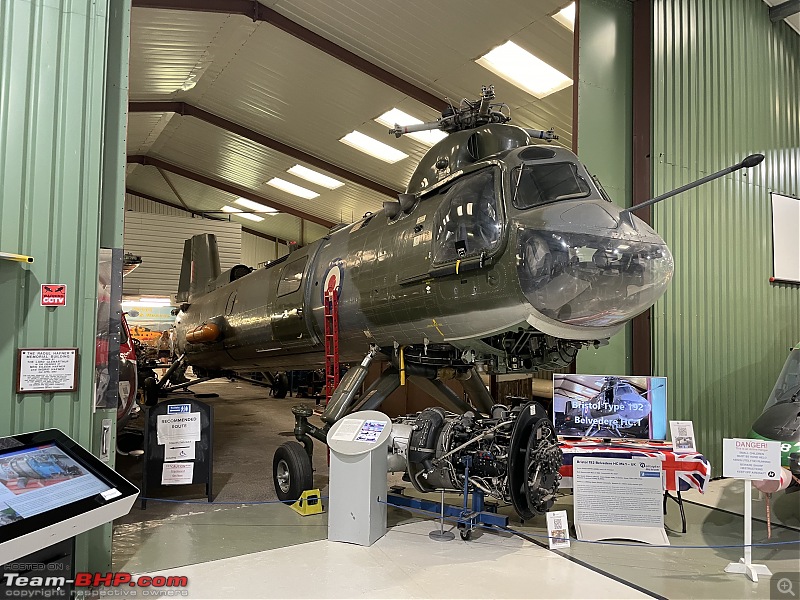 Then you turn towards the main entrance of the museum and you are beginning to feel you are in a pretty special place, helicopter wise that is!  Apart from the many helicopters on display there were quite a few gyrocopters as well. Here we see a McCulloch J2. The McCulloch J-2 was a small, two-seat autogyro with an enclosed cabin, one of only three designs of this type of aircraft to receive a type certificate in the United States. It was built by McCulloch Aircraft Corporation. Design and development It was designed by Drago Jovanovich and first flew in June 1962. McCulloch acquired the design in 1969 and put it into production, building 83 aircraft over the next three years. They were reported to sell for US$15,900. The design featured a belt clutch and a transmission which could be engaged to spin the rotor blades to high speed before take-off to produce short takeoff runs. A lever on the rear cockpit wall would select the drive position for the transmission. A single "spin-up lever" on the cockpit left side would then be pressed downward, operating as a collective pitch control to put the blades into flat pitch while simultaneously tensioning the belt clutch. The rotor could be spun to over 500 rpm before takeoff, well above the normal flight range (typically 425 rpm). Release of the spin-up lever would disengage both the clutch and the transmission, while placing the blades into flight pitch. After a very brief takeoff run (typically 25 to 200 feet, depending upon load and winds) adequate flight airspeed would be attained, while the rotor speed decayed to the normal flight range. The rotor was not engine-driven in flight. A strong spring resisted accidental depressing of the spin-up lever while airborne. Dual controls were provided for all functions except the spin-up lever, which was accessible only from the left seat. The aircraft enjoyed nimble handling with light control forces, but suffered from a shallow climb gradient. McCulloch J-2 registered in the United Kingdom between 1972 and 1975 Early versions were equipped with a two-bladed wooden Sensenich propeller. A later "Super J-2" variant employed a three-bladed Hartzell controllable-pitch propeller, accompanied by an increase in allowable gross weight. Baggage of up to 95 pounds, to the extent permitted by gross weight considerations, could be carried in a large bay under the seat. Fuel was carried in tanks in the stub wings. A total of 24 U.S. gallons could be carried, 12 on each side, but only 20 were usable through normal flight attitudes. At a typical fuel burn rate of about eight gallons per hour and economy cruise at about 85 mph, with a need for a safety reserve, this limited the aircraft's range.[citation needed] The rotor system (hub and blades) is very similar to that found on the early versions of the Hughes 269 / Schweizer 300 series helicopters. The primary difference is in the twist of the blades (or lack thereof), optimized for autorotation in the case of the J-2. Most examples of the J-2 were sold to pilot owners in the United States but at least one example was exported to the United Kingdom.  The next chopper is an Sur Aviation SA318 Alouette. I have fond memories of this little chopper. The Dutch airforce used these. When in my late teens I really wanted to become a pilot. As I had very poor eyesight, in those days, simply no chance! But the loophole was helicopters. For some strange reason the Airforce allowed helicopter pilots to wear spectacles. So I applied and was invited. But then turned down because of my height (1.93m). Very frustrating because I had filled out at least a dozen forms for my application and all of them mentioned my height, but apparently nobody ever reads those forms. The Aérospatiale Alouette III (French pronunciation: [aloo-wɛt], Lark; company designations SA 316 and SA 319) is a single-engine, light utility helicopter developed by French aircraft company Sud Aviation. During its production life, it proved to be a relatively popular rotorcraft; including multiple licensed manufacturers, more than 2,000 units were built. The Alouette III was developed as an enlarged derivative of the earlier and highly successful Alouette II. Sharing many elements with its predecessor while offering an extra pair of seats and other refinements, it quickly became a commercial success amongst both civil and military customers. Further variants were also developed; amongst these was a high-altitude derivative, designated as the SA 315B Lama, which entered operational service during July 1971. The Alouette III was principally manufactured by Aérospatiale; the type was also built under licence by Hindustan Aeronautics Limited (HAL) in India as the HAL Chetak, by Industria Aeronautică Română (IAR) in Romania as the IAR 316 and F+W Emmen in Switzerland. Similar to the Alouette II, in military service, it was used to perform missions such as aerial observation, photography, air-sea rescue, liaison, transport and training; it could also be armed with anti-tank missiles, anti-shipping torpedoes, and a fixed cannon. In a civilian capacity, the Alouette III was commonly used for casualty evacuation (often fitted with a pair of external stretcher panniers), crop-spraying, personnel transportation, and for carrying external loads. By the 2010s, many operators were in the process of drawing down their fleets and replacing them with more modern types; the French military intend to replace their Alouette IIIs with the newly developed Airbus Helicopters H160.  Next I walked against this magnificent red helicopter. Actually, I did recognise the type, but not this particular one. I just thought it would make for a cool, frontal wide angle shot, which, you will admit it does!!  It is a Wessex HCC mk4 and it was used extensively as the Queens flight!! It was retired in 1998, to be replaced by the far more economic and comfortable Sikorsky S-76. Here a peek into the Royal cabin; Sorry, lousy image, but my iPhone does not do better shooting through protective plexiglas.  The RAF used this chopper in mk2 version from 1963 and it was decided that the last two choppers rolling of the production line were to be for the exclusive use of the Queen Flight under the designation HCC mk4. This particular chopper has been piloted by both the then Duke of Edinburg, prince of Wales and his son the Duke of York. It has carried HRH Princess Anne, Princess Diana, Princess Margaret, Queen mother, Prince William as well as many other heads of states and VIPs. This particular chopper was purchased by the museum with the aid of the National Lottery. (which funds a lot of these sort of heritage / cultural causes. Glad I bought so many lottery tickets over the years!! I will say this though; it might be Royal plush and posh, but flying any chopper is uncomfortable, no matter what. They rattle, they shake, the noise is deafening. Modern helicopters are a bit bette, but a far cry from the comfort of a modern jet. Of course, British Royalty, stiff upper lip and all of that, never complained. Just a few more image to get a sort of feeling of this place. It is not that big, but it is absolutely crammed with helicopters!!  Its impossible to shoot one helicopter without getting at least the rotor of another chopper in your image.  Here another one of my favourites, the Westland Whirlwind. The Westland Whirlwind helicopter was a British licence-built version of the U.S. Sikorsky S-55/H-19 Chickasaw. It primarily served with the Royal Navy's Fleet Air Arm in anti-submarine and search and rescue roles. In 1950, Westland Aircraft, already building the American Sikorsky S-51 under licence as the Westland Dragonfly, purchased the rights to manufacture and sell Sikorsky's larger Sikorsky S-55 helicopter. While a Sikorsky-built pattern aircraft was flown by Westland in June 1951, converting the design to meet British standards (including the provision of a revised main-rotor gearbox), was time consuming,[1] and the first prototype British aircraft, registered G-AMJT, powered by the 600 hp Pratt & Whitney R-1340-40 Wasp did not fly until August 1953.[2] This was followed by ten Whirlwind HAR.1s, which entered service shortly afterwards. They served in non-combat roles, including search and rescue and communications functions. The HAR.3 had a larger 700 hp Wright R-1300-3 Cyclone 7 engine. The performance of early versions was limited by the power of the American Wasp or Cyclone engines, and in 1955, the HAR.5, powered by an uprated engine, the Alvis Leonides Major, flew for the first time.[3] This was followed by the similarly powered HAS.7, which became the first British helicopter designed for anti-submarine warfare in the front-line when it entered service in 1957. It could either be equipped with a dipping Sonar for submarine detection or carry a torpedo, but could not carry both simultaneously, so sonar equipped "Hunters" were used to direct torpedo armed "Killers".[4] The HAS.7 was powered by a 750 hp (560 kW) Alvis Leonides Major 755/1 radial engine. It had a hovering ceiling at 9,400 ft (2,900 m) and a range of 334 miles at 86 mph. In 1960 Westland introduced a Whirlwind powered by the 1,000 hp Bristol Siddeley Gnome turboshaft, the greater power giving much improved performance over the earlier piston-engined variants; helicopters receiving this modification were redesignated as the HAR.9. The Gnome featured an early computer controlled fuel system that removed variations in engine power and made for much easier handling by the pilot. More than 400 Whirlwinds were built, of which nearly 100 were exported to foreign customers 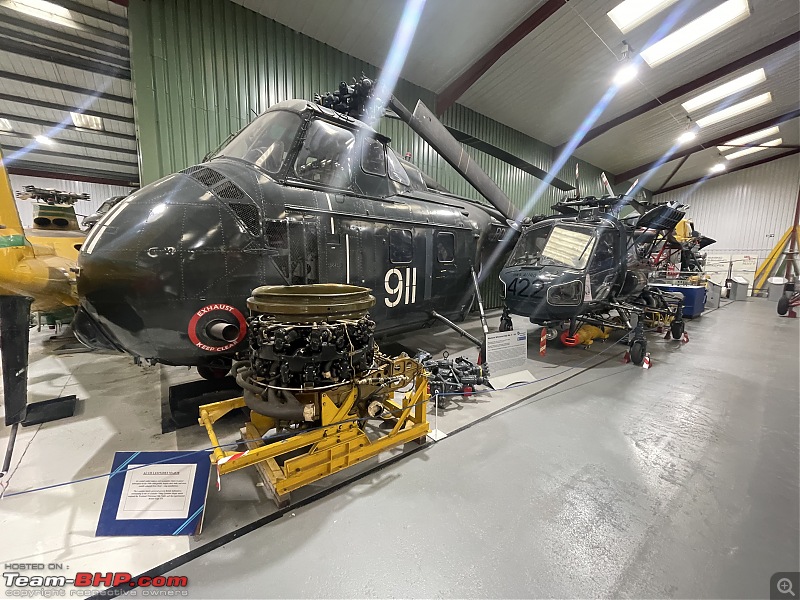 Another fond memory of this little chopper, the Wasp. The Dutch navy operated a squadron of Wasp’s from our anti-submarine frigates. The Westland Wasp is a small 1960s British turbine powered, shipboard anti-submarine helicopter. Produced by Westland Helicopters, it came from the same P.531 programme as the British Army Westland Scout, and is based on the earlier piston-engined Saunders-Roe Skeeter. It fulfilled the requirement of the Royal Navy for a helicopter small enough to land on the deck of a frigate and carry a useful load of two homing torpedoes. The Wasp sank one ship in combat, seriously damaging the ARA Santa Fe submarine in 1982 during the Falklands war.  Look at some of the engine details of this Wasp. Can you imagine, this thing shaking, rattling, everything in the open, being buffeted by downdraft from the rotor? It is just remarkable anything like this can not only fly, but can fly reasonably save! And drop a torpedo or two whilst doing so!! 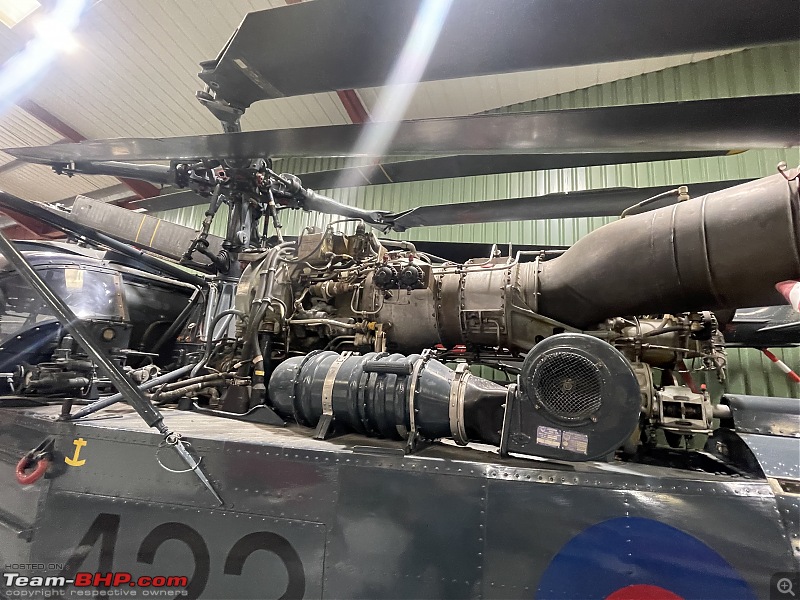 Another well known chopper for many, the Westland Dragonfly. It took to the air for the first time in 1948! Making the start of what would become one of the world’s leading helicopter manufacturers Westland. It was also licensed to the Americans. This particular aircraft is production number 50. First flight on 19th of September 1952! Even an old git such as me, was not even born!!  More Westland choppers, the Wesses HAS mk1. In essence Westland took a piston engined Sikorsky S-58 and replaced the radial engine with a British Napier Gazelle Turboshaft. initially developed for a anti submarine role. One of the important advantages of the turbojet engine over the radial engine, was its use of proper kerosine. Which is far less flammable and therefor much safer onboard navy ships.  For our comrades on the forum, I have taken some images of various Russian helicopters as well. Personally, I liked this one. If anything it was made famous because of a (Western) movie and not so much the Russian army. Which I consider a bonus, especially these days. 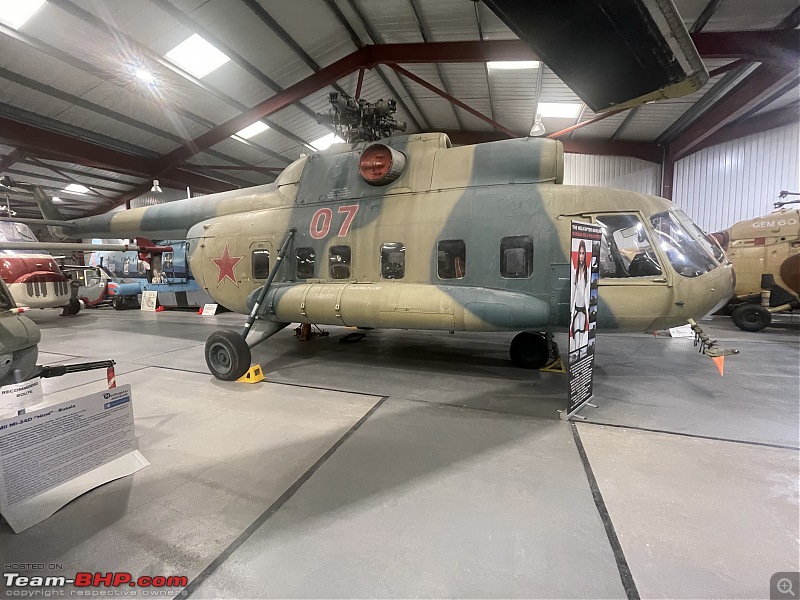 This, apparently, is the actual helicopter seen in the movie “Black Movie”. I have not seen the movie, but I understand it starred Scarlett Johansson. A good enough reason to go and see this movie!  There were a few more Russian choppers on display, Here the famous, if not infamous Hind. The Mil Mi-24 (Russian: Миль Ми-24; NATO reporting name: Hind) is a large helicopter gunship, attack helicopter and low-capacity troop transport with room for eight passengers. It is produced by Mil Moscow Helicopter Plant and has been operated since 1972 by the Soviet Air Force and its successors, along with 48 other nations. In NATO circles, the export versions, Mi-25 and Mi-35, are denoted with a letter suffix as "Hind D" and "Hind E". Soviet pilots called the Mi-24 the "flying tank" (Russian: летающий танк, romanized: letayushchiy tank), a term used historically with the famous World War II Soviet Il-2 Shturmovik armored ground attack aircraft. More common unofficial nicknames were "Galina" (or "Galya"), "Crocodile" (Russian: Крокодил, romanized: Krokodil), due to the helicopter's camouflage scheme, and "Drinking Glass" (Russian: Стакан, romanized: Stakan), because of the flat glass plates that surround earlier Mi-24 variants' cockpits. This particular chopper is a MII MI 24D Hind. I think the Russian helicopters are designed to look particular menacing!! 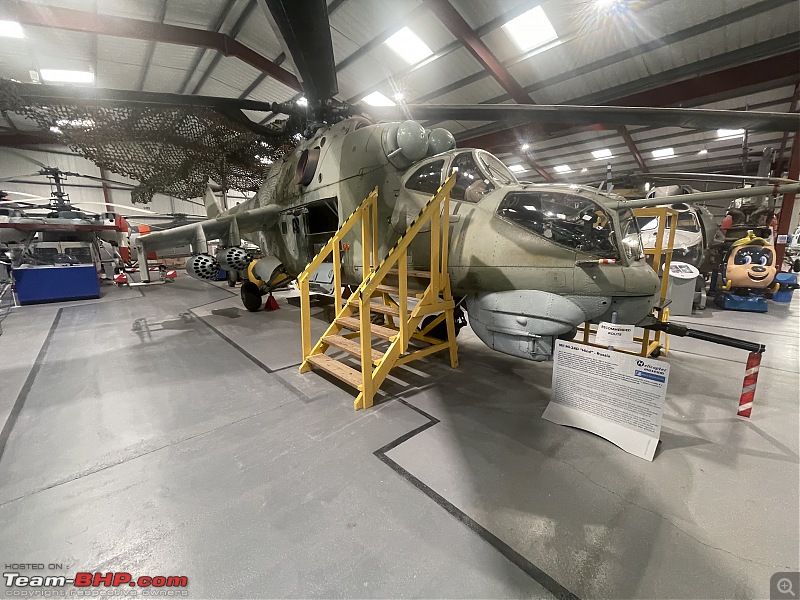 I took a few images of the forward and rear cockpits. The chopper is flown from the rear cockpit:  From the forward cockpit the various guns/missiles etc are operated.  I am not a huge fan (to put it mildly) of Russia, or the former Soviet Union, or anything they stood for. But they knew how to build some outstanding aircraft. This Hind being one of them. I did quite a bit of reading up on it. Very impressive. I came across this article about an American pilot who got to fly these machines. It is interesting to read how American and Russian design differs, right down to how these machines are operated. https://verticalmag.com/features/get...nt-mi-24-hind/ Trust me, you do not want to be on the receiving end of this, or anything a Hind can throw at you!!  Moving on to some more modern choppers, the EH Industries EH101. This chopper was produced by a joint venture of Westland and Augusta to come up with a replacement of the ageing SeaKing and similar Sikorsky S62. This particular aircraft was the third prototype and flew first in September 1988. It is powered by three General Electric turbine jets.  I was very pleased to stumble upon this piece of magnificent engineering. It is known as a deck lock. Landing a chopper on a rolling and pitching deck is one thing, but keeping it on a rolling and pitching deck is another! Leave it to the Brits to come up with a clever device. Essentially the idea was to shoot a barbed harpoon attached to the belly of the chopper into a grid built onto the flight deck of the ship. This basic idea evolved over the years. These days it is a hydraulically activated harpoon system. It is capable of locking choppers to the deck in very severe sea states. In fact, if the ship was to capsize, the harpoon would still hold the chopper in place.  Have a look at this video of a modern variant, quite amazing. For the next chopper I need to revert back to the second image on this post. A very special helicopter. To this day it holds the world speed record for rotor aircrafts. You can see it in the second image, the on the immediate right with the word Lynx written on its nose.  I spend quite a bit of time at this chopper, there was a lot to read up and take in. Quote:
For all intents and purposes, this was a very heavily modified Lynx. It has nothing to do with a regular production version. Still, makes for quite the achievement. One of the main problems with a helicopter going fast is the speed of the rotor blade. Once they reach supersonic speed all sorts of problems occur. In layman’s term, once the tip of your rotor breaks the sound barrier you will crash and you will die! It took a very specially designed rotor to solve this problem. Also, a different engine and even that could only be run at max power for a few minutes. It needed a stronger tail rotor to counter the forces of the now more powerful rotor and it needed quite a bit of strengthening along its main structural components as well. Everything not needed for maximum speed was ditched. Quite remarkable. Here some more information and some good images of the said Lynx chopper: https://www.thisdayinaviation.com/ta...1-lynx-g-lynx/ At the very rear of the museum you will find their workshop. A lot of restoration work is carried out in house, mostly by volunteers. Here you see, amongst other a Piasecki H-21, commonly referred to as the flying banana! 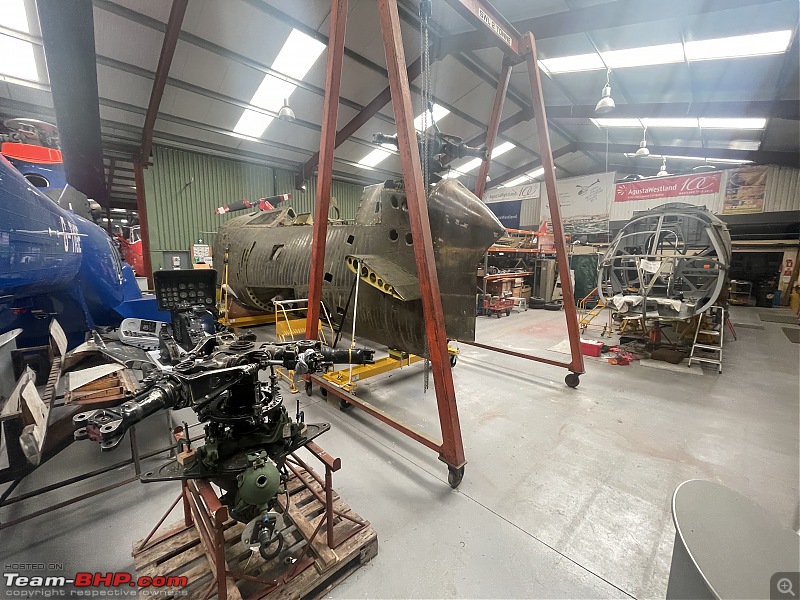 Last edited by Jeroen : 27th September 2022 at 03:53. | |
| |  (24)
Thanks (24)
Thanks
 |
| The following 24 BHPians Thank Jeroen for this useful post: | ads11, akbaree, ampere, anivy, BlackBeard, BrokenHW, GaryTSI, GForceEnjoyer, GTO, haisaikat, InControl, naveen.raju, Omkar, PreludeSH, rajesh1868, Rehaan, Reinhard, Sunny_ST3, V.Narayan, v1p3r, vb-saan, vigsom, whitewing, ysjoy |
| | #3 |
| Distinguished - BHPian  | re: England in a nutshell | Rolling hills, castles and helicopters! More helicopters!! Not sure if the TV series MASH was shown in India. It came after the movie MASH. It is one of the longest running TV series ever. It is about army doctors during the Korean war working in one of the American MASH units. (Mobile Army Surgical Hospital). The running joke was that the series lasted considerable longer than the actual Korean war. I must admit I am a huge fan on the TV series. A real classic. The Korean war theatre was the first to see large scale deployment of helicopters. Primarily in a supporting role and in getting wounded soldiers quickly to these MASH units. If you have seen the movie or the TV series you will have seen this one, It is right there in every opening sequence.  It is an Agusta Bell 47G. The Bell 47 is a single-rotor single-engine light helicopter manufactured by Bell Helicopter. It was based on the third Bell 30 prototype, which was the company's first helicopter designed by Arthur M. Young. The 47 became the first helicopter certified for civilian use on 8 March 1946.[1][2] The first civilian delivery was made on 31 December 1946 to Helicopter Air Transport.[3] More than 5,600 Bell 47s were produced, including those under license by Agusta in Italy, Kawasaki Heavy Industries in Japan, and Westland Aircraft in the United Kingdom. The Bell 47J Ranger is a modified version with a fully enclosed cabin and tail boom. The Bell 47 entered US military service in late 1946, and operated in a variety of versions and under different designations for three decades. It was designated H-13 Sioux by the US Army, and during the Korean War, it served a variety of roles, including reconnaissance and scouting, search and rescue, and medevac. The "Telecopter" was a Bell Model 47 rented by television station KTLA in Los Angeles, California. It was outfitted with a television camera and it made the world's first flight by a television news helicopter on July 3, 1958, with its inventor, John D. Silva, aboard. When the television station reported it was receiving no video, Silva exited the helicopter's cockpit to climb onto its landing skid while it hovered at 1,500 feet (457 m) so he could investigate the microwave transmitter bolted to its side, where he discovered a vacuum tube had failed due to vibration and hot weather. After Silva fixed the problem overnight, the Telecopter made the world's first successful television news flight on July 4, 1958.[9] The National Aeronautics and Space Administration (NASA) had a number of Bell 47s during the Apollo program, used by astronauts as trainers for the lunar lander. Apollo 17 commander Eugene Cernan had a nearly disastrous crash into the Indian River in Florida in 1971, before his flight to the moon.[10] The 47 has also served as the helicopter of choice for basic helicopter flight instruction in many countries. Very simple and basic helicopter, look at the cockpit!  The next war, Vietnam, saw a much broader deployment of all kinds of helicopters. The most iconic one, no doubt, is the Bell UH-1 Iroquois (commonly known as "Huey")  The Bell UH-1 Iroquois (nicknamed "Huey") is a utility military helicopter designed and produced by the American aerospace company Bell Helicopter. It is the first member of the prolific Huey family, as well as the first turbine-powered helicopter in service with the United States military. Development of the Iroquois started in the early 1950s, a major impetus being a requirement issued by the United States Army for a new medical evacuation and utility helicopter. The Bell 204, first flown on 20 October 1956, was warmly received, particularly for the performance of its single turboshaft engine over piston engine-powered counterparts. An initial production contract for 100 HU-1As was issued in March 1960. In response to criticisms over the rotorcraft's power, Bell quickly developed multiple models furnished with more powerful engines; in comparison to the prototype's Lycoming YT53-L-1 (LTC1B-1) engine, producing 700 shp (520 kW), by 1966, the Lycoming T53-L-13, capable of 1,400 shp (1,000 kW), was being installed on some models. A stretched version of the Iroquois, first flown during August 1961, was also produced in response to Army demands for a version than could accommodate more troops. Further modifications would include the use of all-aluminium construction, the adoption of a rotor brake, and alternative powerplants. The Iroquois was first used in combat operations during the Vietnam War, the first examples being deployed in March 1962. It was used for various purposes, conducting general support, air assault, cargo transport, aeromedical evacuation, search and rescue, electronic warfare, and ground attack missions. Armed Iroquois gunships carried a variety of weapons, including rockets, grenade launchers, and machine guns, and were often modified in the field to suit specific operations. The United States Air Force also deployed its Iroquois to Vietnam, using them to conduct reconnaissance operations, psychological warfare, and other support roles. Other nations' armed air services, such as the Royal Australian Air Force, also dispatched their own Iroquois to Vietnam. In total, around 7,000 Iroquois were deployed in the Vietnam theatre, over 3,300 of which were believed to be destroyed. Various other conflicts have seen combat deployments of the Iroquois, such as the Rhodesian Bush War, Falklands War, War in Afghanistan, and the 2007 Lebanon conflict. The Iroquois was originally designated HU-1, hence the Huey nickname, which has remained in common use, despite the official redesignation to UH-1 in 1962.[1] Various derivatives and developments of the Iroquois were produced. A dedicated attack helicopter, the Bell AH-1 Cobra, was derived from the UH-1, and retained a high degree of commonality. The Bell 204 and 205 are Iroquois versions developed for the civilian market. In response to demands from some customers, a twin-engined model, the UH-1N Twin Huey, was also developed during the late 1960s; a four-bladed derivative, the Bell UH-1Y Venom, was also developed during the early twenty-first century. In US Army service, the Iroquois was gradually phased out following the introduction of the Sikorsky UH-60 Black Hawk and the Eurocopter UH-72 Lakota, although hundreds were still in use more than 50 years following the type's introduction. In excess of 16,000 Iroquois have been built since 1960. Compared to the Bell 47 a much more sophisticated cockpit.  And now for something completely different. Look at this contraption!  It is a Russian Ka26 Hoodlum. Never heard of it, never saw anything like it before. The Kamov Ka-26 (NATO reporting name Hoodlum) is a Soviet light utility helicopter with co-axial rotors. The Ka-26 entered production in 1969 and 816 were built. A variant with a single turboshaft engine is the Ka-126. A twin turboshaft-powered version is the Ka-226. (All the Ka-26/126/128/226 variants are code-named by NATO as "Hoodlum”). The fuselage of the Ka-26 consists of a fixed, bubble-shaped cockpit containing the pilot and co-pilot, plus a removable, variable box available in medevac, passenger-carrying and crop duster versions. The helicopter can fly with or without the box attached for flexibility. It is powered by two 325 hp (239 kW) Vedeneyev M-14V-26 radial engines mounted in outboard nacelles. The Ka-26 is small enough to land on a large truck bed. The reciprocating engines are more responsive than turboshaft engines, but require more maintenance. It runs mostly at 95% power in crop dusting with usually excess payload, leaving little reserve power for emergencies. Due to frequent overloads, the interconnect shaft joining the two engines is prone to breakage and requires frequent inspection. The standard instrumentation of the Ka-26, like larger naval Kamovs, may be overkill for civilian or crop dusting use. The 18-dials cockpit panel masks a part of the right-downwards view, needed to avoid telephone and power lines at low altitudes. The instrument panel may be simplified to retain the six main dials. As there is a low rotor clearance at the aircraft front, it is approached from the rear when the rotors are turning. Due to the limitations of the Ka-26, USSR and Romania agreed under the Comecon trade to build a single-turboshaft engine version, the Kamov Ka-126, with better aerodynamics and range. Here was another very interesting thing I found. Are there helicopters with ejection seats I hear you ask? The answer might surprise you! Two helicopters have flown with ejection seats. The Sikorsky S72 and the Russian KA50 attack helicopter had ejection seats. In both instances, the main rotor blades are first blown off by explosive bolts at the very beginning of the ejection sequence. It has been tested on the ground with dummies, but neither chopper used it for real ever. However, choppers do come with so called “stroking seats”. When you crash in your helicopter it is all about absorbing the impact. Such a stroking seat rides up a tubular rail on impact and gives additional impact protection.  Helicopter have other design features to lessen the impact of a crash as well. Such as wheels that collapse rearward and honeycomb structure under the floor. This particular seat was manufactured as a one off by Martin Baker. (The same company that pioneered the ejection seat and is still a world leader in this domain. This model was developed further and you might encounter modern stroking seat in civilian and military helicopters. Some more general impressions of the museum. Everywhere you look or go it is helicopter galore!   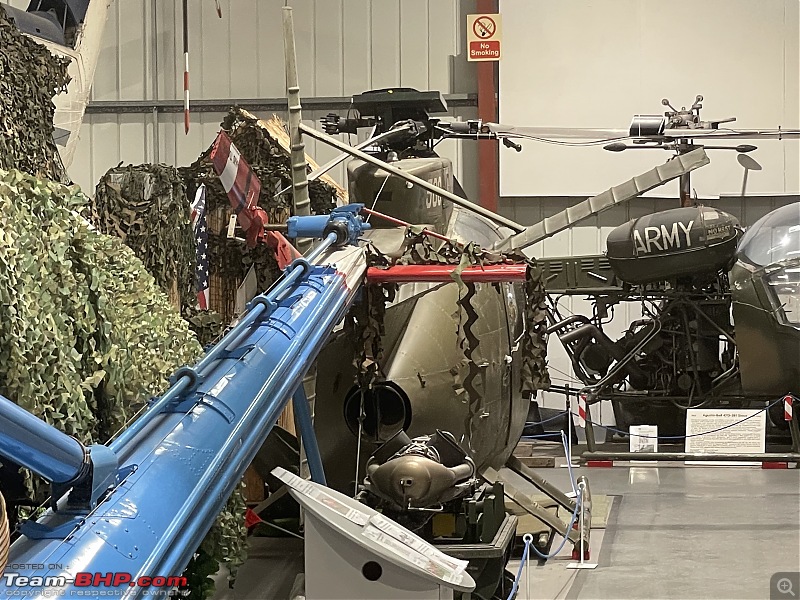 Many chopper pilots these days might have had their initial training on this little helicopter, the Robinson R22 HP. It was designed specifically for the private owner market, was relatively cheap, very reliable and handled well. More than 3000 R22 were produced and many of them are still flying today!  From the tiny to the extra large. The French Sur SA321F Super Frelon. A monster, three engined helicopter. Designed initially for the military, with rear loading ramp . This particular aircraft is the commercial prototype version. It reached 175 km/h with a 34-37 passenger cabin configuration had a range of 920km. Olympic Airways (Owned by Onasis at the time) had two of these to connect various Greek islands.  When I first learned about this museum I was hoping it had a real Fairly Rotdyne. Unfortunately it did not, but it did have some of its parts on display.  Helicopters have come a long way from those early little whirlwind. I think this part illustrates it well. It is the main rotor hub of an Augusta Westland EH101. For reference/size you see my shoe (size 46) at the bottom. This thing is absolutely massive. All of this spins around, holds and manipulates the rotor blades whilst providing lift and thrust. It is truly mind blowing!!  There is more to see in this wonderful museum. This is just a random selection by me. This museum is not very big in terms of physical space. But they have managed to cram in a huge amount of helicopters and helicopter related stuff into this building. I spend about 2,5 hours and I could have spend more. I got to see some helicopters I had heard and read about, but never seen in real life. Also, I learned a lot during my visit. The whole collection is well curated. Each aircraft comes with a large sign explaining each aircraft. It also comes with a QR code you can scan on your mobile for more information on each helicopter. Very neat! If you are interested in aviation and technology a visit to the helicopter museum if you are in the area is highly recommended. Last edited by Jeroen : 27th September 2022 at 00:45. |
| |  (28)
Thanks (28)
Thanks
 |
| The following 28 BHPians Thank Jeroen for this useful post: | ads11, akbaree, ampere, anivy, BlackBeard, BrokenHW, clement.lloyd, dailydriver, DicKy, GForceEnjoyer, GTO, haisaikat, InControl, Omkar, PreludeSH, rajesh1868, Ravi Parwan, Rehaan, Reinhard, Satish Pari, sukhbirST, V.Narayan, vb-saan, vigsom, Vishal.R, wbd8779, whitewing, ysjoy |
| | #4 |
| Distinguished - BHPian  | re: England in a nutshell | Rolling hills, castles and helicopters! After the helicopter museum I walked back to a local train station and took the train back to Bath. It was a splendid day and Bath looked beautiful.  My wife had a as good and as interesting day as me, so we were both very content. Had a drink and went out for some food. This time we decided on a little tapa like restaurant we had heard about and came highly recommended. 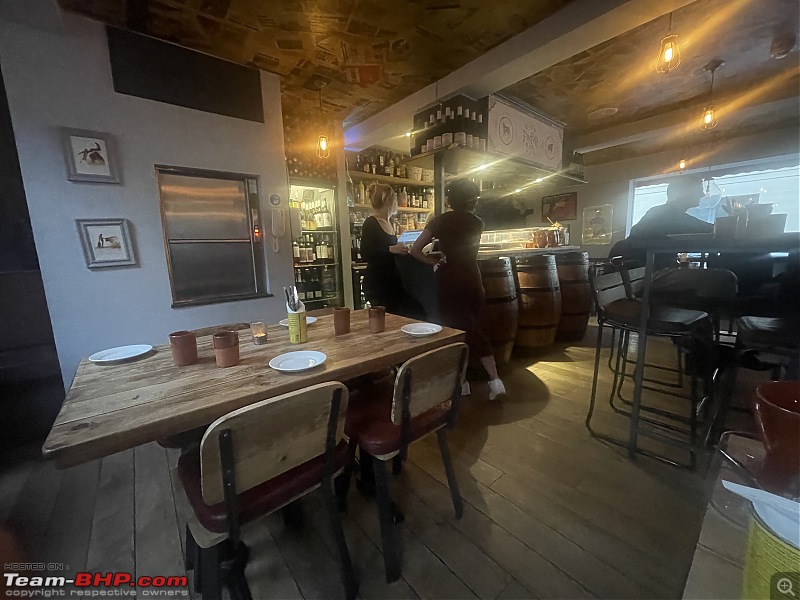 The food was absolutely scrumpteous, a really great meal! We love these tapa meals. You can try a variety of different dishes, tastes, meats, vegan etc. 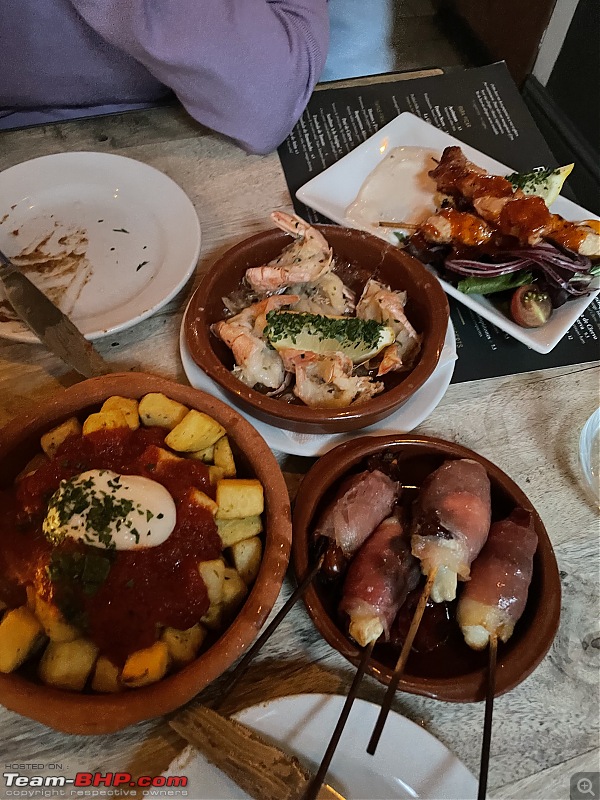 We walked home to our hotel. Parts of Bath are nicely lit up.  The next day was Monday the 19th of September. As you might recall that was the day of the queens funeral. Of course, when we booked our trip, we did not know this would happen. Because we knew just about everything was going to be closed we had decided to stay in Bath for two nights. We would spend the Monday travelling back toward Essex/Suffolk. It was a long drive and we figured by 1500 PM pubs would start to open. We had made a hotel booking in Woodbridge, Suffolk. Quite a drive from Bath. Nothing was open on Monday morning in Bath. Even less than on a usual bank holiday. Luckily enough we had anticipated this and had bought some breakfast food to eat in our room before we checked out. We drove the whole morning. We stopped once for coffee and petrol (petrol stations were open). We listen to BBC from 09.00 till about 14.00 hours. We also pulled off the motorway, so we could stop for the two minute silence around 11.00 o’clock. In all honesty, I am not a fan of any monarchy and certainly not the British Monarchy. Still, listening to the radio on how the nation dealt with the death of her queen was impressive. We decided to head for the little town of Maldon, Essex. For no other reason as it well known to us. It has a very nice waterfront with two lovely pubs and we hoped at least one would be open. We managed to park right in front of our favourite pub, along the quayside.  We had a little stroll. It was low tide, which means the river Chelmer runs very low. Boats along the quayside are left to dry out on the mud!   The pub was open and offered a very simple, limited menu. No problem.  With still an hour driving ahead of us, no alcohol! After our lunch we walked around a bit more. This is a very attractive part of Essex.  We have been coming here for the better part of 25 years. We saw this steam tug the very first time we came. It was in a very sorry state. Over the years, more and more work has been done on it. It is now owned by a very active society, run by volunteers, and they aim to bring it back to a fully operational steam tug in the near future.  After about an hour and a half we drove onwards to Woodbridge. Again, we know Woodbridge very well. Especially Suffolk is our old stomping ground. We loved to come to Woodbridge to spend the day. Lots of little antique shops, ateliers, a marina and you can walk along the river Deben for hours. Like the river Chelmer in Maldon, the Deben is also very much a tidal river. Substantial difference between high and low tide.  One of the attraction of Woodbridge is its tidal mill.  We had booked a very nice room in the Bull Inn. We had the occasional drink there, but never stayed there. It was excellent. We had dinner there too, again outstanding and a fantastic breakfast the next day. I had made a reservation for our car too. We know parking in Woodbridge can be a bit of a pain. Luckily the Bull Inn has some parking for its guests. You get your own personalised parking cone to ensure nobody else parks in your spot. 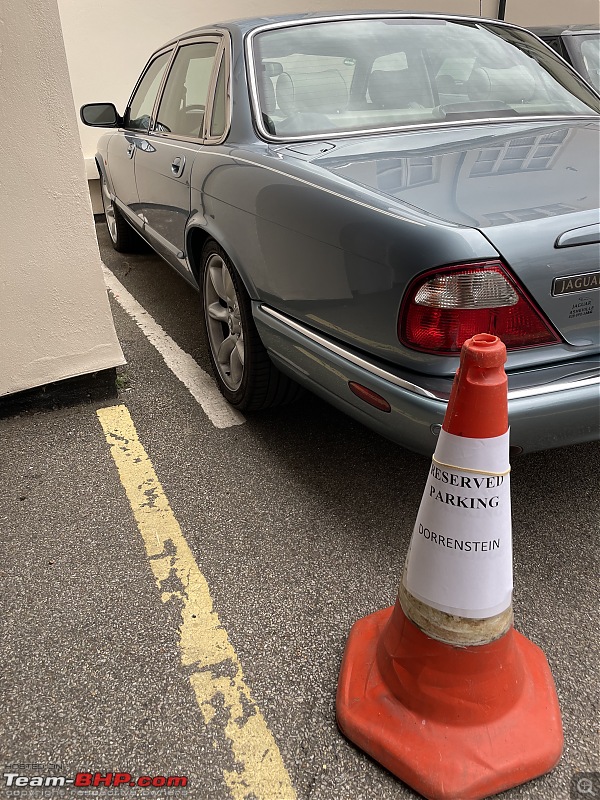 If you ever stay in or near Woodbridge we can recommend the Bull Inn! https://www.bullinnwoodbridge.co.uk Tuesday was going to be our last day. We spend most of the day doing some shopping. Around lunch time we drove to our absolute favourite pub at pin hill, the Butt and Oyster. https://www.debeninns.co.uk/buttandoyster/ We used to come here regularly for lunch, or late afternoon to have a drink, relax and look at the boats. It is located on the river Orwell, which runs from Harwich/Felixstowe toward Ipswich. Again a very tidal river. The weather had been great during our trip. Partly sunny, temperatures around 20-21oC. Perfect weather to sit outside on a pub terrace.  Look at how far the river has withdrawn. During high tide the water will be against the walls of the Butt and Oyster!  These tidal rivers make for careful planning when you want to take your boat out. These owners will have to wait for several hours before the hight tide comes in.  Around 17.00 hours we drove back into Ipswich. We visited our old neighbour Peter. His wife Martha died last year during the pandemic. He is well into his eighties. They used to look after our home across the street. Very convenient for us. Peter would mow the grass, let the service engineers in to service the boiler and so on. They had a lot of friends and family living abroad as well. When they visited they could stay in our home. Worked really well for all of us. Whenever we are near Ipswich we try to see Peter. By 1900 it was time to head for Harwich, the Stena Terminal. About 40 minutes drive. However, the main road to Harwich had terrible congestion. Luckily, my TomTom GPS provided us with a very nice rural road alternative and we got there with no delay. Waiting as we have past check in, immigration and customs.  The Ferry is ready for us!  It does not sail until 23.00, but boarding tends to start around 20.30 and I like to be at the front of the queue of cars driving onto the ferry ramp. We were parked on the upper deck. A bit of a squeeze. And a pain disembarking as they need to empty the decks below us first.  We docked on time at 08.00 local time in Hook of Holland. Took about 30 minutes before we managed to get of the Ferry and past immigration and customs. We were home at 10.30 or thereabouts. The Jaguar performed flawlessly. We drove a total of 1210 km. 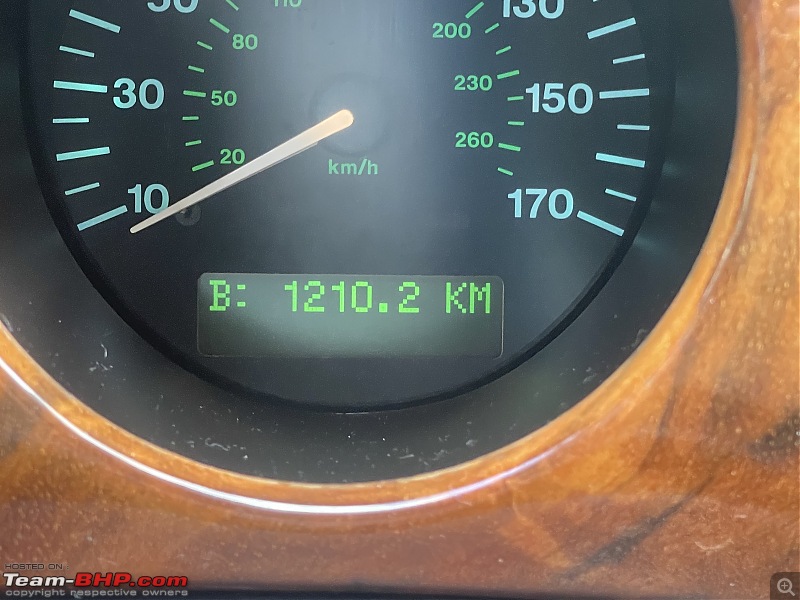 We used almost 148 litres of petrol  Which means an average fuel efficiency of 12,2l/100km or 1:8,1 Which is not bad for this car, its 4.0L supercharged V8 and my sort of driving.  All in all, a very successful and very enjoyable trip! jeroen Last edited by Jeroen : 27th September 2022 at 01:36. |
| |  (58)
Thanks (58)
Thanks
 |
| The following 58 BHPians Thank Jeroen for this useful post: | aah78, akbaree, ampere, anivy, aqualeo2040, Blessings21, BrokenHW, carthick1000, catchjyoti, dailydriver, deep_behera, DicKy, dkaile, dmplog, drift87, Dry Ice, GaryTSI, GForceEnjoyer, GTO, haisaikat, IcarusMan, InControl, itwasntme, jayakumarkp, Karthik Chandra, MadHawk, mallumowgli, mugen_pinaki27, naveen.raju, Omkar, PearlJam, PreludeSH, psispace, rajesh1868, Ravi Parwan, Rehaan, Reinhard, Ritzvxi, rj22, sainyamk95, Satish Pari, sgm, Shreyas Aterkar, sukhbirST, Sunny_ST3, thallipolivandi, The Rationalist, thewhiteknight, thisissoumya, toothless, TrailBlazer007, V.Narayan, VaibhaoT, vb-saan, vigsom, Vinod_nair, wbd8779, yogiii |
| | #5 |
| Team-BHP Support  | re: England in a nutshell | Rolling hills, castles and helicopters! Thread moved to the Travelogues section. Thanks for sharing. |
| |  (4)
Thanks (4)
Thanks
 |
| The following 4 BHPians Thank benbsb29 for this useful post: | GTO, Jeroen, Omkar, vb-saan |
| | #6 |
| BHPian Join Date: Apr 2009 Location: London
Posts: 621
Thanked: 1,010 Times
| re: England in a nutshell | Rolling hills, castles and helicopters! Beautiful Pictures and very well written, as always. My landlord in England had a Jaguar XJR in beautiful green. He used to drive me around in the Jag for miscellaneous work and I used to early wait for his call in the weekend just to sit in the Jag.  Though I had heard of the Helicopter Museum, but never got a chance to visit. Something to look forward to when I visit Bath City next time Regards |
| |  (2)
Thanks (2)
Thanks
 |
| The following 2 BHPians Thank chandrda for this useful post: | Jeroen, rj22 |
| | #7 |
| BHPian | Re: England in a nutshell | Rolling hills, castles and helicopters! Mind-blowing pictures accompanied by amazing detail. Hats off. The part about the helicopters and particularly the Bell 47G made my day, since I love aviation. And M*A*S*H was, in fact, shown in India. My dad once told me about watching it during his childhood. It was actually recently on Tata Sky specials or something similar in 2021, which is when I also watched it; fantastic series. Your Jaguar might just be one of the best maintained "big cats" I've ever seen! It also looks unbelievably elegant and wonderfully proportioned. Great to see it being driven and fully enjoyed. Hats off once again.  Last edited by GForceEnjoyer : 27th September 2022 at 11:54. |
| |  (3)
Thanks (3)
Thanks
 |
| The following 3 BHPians Thank GForceEnjoyer for this useful post: | anivy, Jeroen, sainyamk95 |
| | #8 |
| Distinguished - BHPian  Join Date: Jan 2010 Location: TVPM
Posts: 3,828
Thanked: 11,812 Times
| Re: England in a nutshell | Rolling hills, castles and helicopters! Casually started reading and scrolled down, only to spend almost a minute looking at the first picture. The XJR looks absolutely ravishing, with that sunlight background.  Since the Goodwood festival and period dressing were mentioned (though separately), reminds me of the Goodwood Instagram page were they have a section called Revive/thrive in which people would dress up in period dresses and hairdos. |
| |  (3)
Thanks (3)
Thanks
 |
| The following 3 BHPians Thank DicKy for this useful post: | Jeroen, Karthik.guru, sainyamk95 |
| | #9 | |
| Distinguished - BHPian  | Re: England in a nutshell | Rolling hills, castles and helicopters! Quote:
Have a look here: https://www.team-bhp.com/forum/diy-d...ml#post4661242 Jeroen Last edited by Jeroen : 27th September 2022 at 17:28. | |
| |  (2)
Thanks (2)
Thanks
 |
| The following 2 BHPians Thank Jeroen for this useful post: | DicKy, Omkar |
| | #10 |
| BHPian Join Date: Apr 2011 Location: Bengaluru
Posts: 617
Thanked: 1,226 Times
| Re: England in a nutshell | Rolling hills, castles and helicopters! Loved your part 1 ��, skipped the helicopter part to be honest. Loved those pics of Bath, and the Corfe Castle one was my favourite. Intrigued to see very few people in all those photos, makes me wonder how, a place like UK, which almost has the same population density as our state of Karnataka, has fewer people around. Maybe it’s more equally spread across, but would love to be educated. We are currently in Thailand on a visit, and am still looking out for the Thai Red Curry and Rice, like the one that we find in Bangalore. There’s more Mango Curry, or Durian stuff here, yet |
| |  (1)
Thanks (1)
Thanks
 |
| The following BHPian Thanks vinya_jag for this useful post: | Jeroen |
| | #11 |
| BHPian Join Date: Aug 2017 Location: Leeds
Posts: 937
Thanked: 2,259 Times
| Re: England in a nutshell | Rolling hills, castles and helicopters! Always a pleasure to read one of your travelogues Jeroen. Going to need to revisit the helicopter museum posts again - some real beauties in there! Was pleasantly surprised to see Woodbridge feature. My girlfriends grandparents are based nearby and we've been meaning to go for ages. Definitely going to ask about the Bull Inn - might have to make a stop over! |
| |  (1)
Thanks (1)
Thanks
 |
| The following BHPian Thanks ads11 for this useful post: | Jeroen |
| |
| | #12 |
| BHPian Join Date: Apr 2012 Location: Delhi
Posts: 917
Thanked: 2,364 Times
| Re: England in a nutshell | Rolling hills, castles and helicopters! Wow that was a very diverse trip. Land, water, nature, and helicopters. Loved the outdoor pics. I could notice that some of the helicopter cockpits can look very busy (likewise planes) with tons of dials and switches. Just wonder how many of these are really used for a typical flight? |
| |  (1)
Thanks (1)
Thanks
 |
| The following BHPian Thanks ajayc123 for this useful post: | Jeroen |
| | #13 | |
| Distinguished - BHPian  | Re: England in a nutshell | Rolling hills, castles and helicopters! Quote:
There are certain buttons required to start and stop the engines, which again are used twice per flight. During engine start pilots will watch the relevant dials intently until the engine has been started properly When flying manual pilot need to scan the so called primary flight instruments constantly. Those are usually, the artificial horizon, altitude, air speed, vertical speed and so on. Pilots learn how to develop such an instrument scan early on. It needs to become second nature. Modern cockpits, so called glass cockpits, tend to have one main flight display, which combines all primary instruments in one display, rather than having 5-8 separate instruments. These days helicopters have them also. However, in this museum all helicopter have gauges. In aviation the old analogue cockpit lay out is often referred to as “steam gauges”. Secondary instruments get scanned less frequently. E.g. you don’t need to check remaining fuel every minute. But you do need to check it regularly and ensure your Fulbright. Is in line with your flight plan. Some switches you hope not to use, ever. E.g. file extinguisher. Most circuitbreakers are left untouched, unless there is a problem. Jeroen | |
| |  (2)
Thanks (2)
Thanks
 |
| The following 2 BHPians Thank Jeroen for this useful post: | ajayc123, DicKy |
| | #14 |
| BHPian Join Date: Jul 2016 Location: London
Posts: 134
Thanked: 600 Times
| Re: England in a nutshell | Rolling hills, castles and helicopters! Nice thread! I got to experience a flight over parts of Suffolk in a Wessex helicopter with 22 Squadron RAF. They were split into "flights" at various bases for air sea rescue. I went up for about 45 mins from RAF Coltishall in Norfolk way back in the summer of 1993 as a 15 year old cadet. Interesting point of note on the Hind - the cockpits of all USSR combat aircraft were painted green for many years because Soviet psychological research determined that it was the most calming colour. Google image search for MiG 21 / 25 / 31, TU-95 etc... cockpits and you'll see green everywhere! Small point of detail, our canal boats are called "narrow boats" not "long boats"  The big sailing vessels at Maldon are known as Thames Barges or Top Sail Barges, Hydrogen dates to 1906. They don't have a deep keel, but instead have barge boards that can be raised and lowered to keep them going straight when the wind is over the bow. The Thames Estuary and Medway have well marked deep channels for modern ships, but in the days of sail, shallow bottom boats were required. I sail round there sometimes on a 8 berth yatch with a 1.8m keel - you have to be very careful with the charts and tides not to run aground even with a modern sonar depth finder. Last time I went, myself and the skipper had to go back out from Chatham at low tide on the Sunday evening to tow a grounded training vessel off! Nice and easy with a Volvo diesel in the stern - in the old days they'd have just had to wait! The larger Thames Barges were very seaworthy and could be handled by a crew of 2. They plied the coastline of the UK and Northern Europe for 200 years. Last edited by Rob UK : 5th October 2022 at 17:32. |
| |  (2)
Thanks (2)
Thanks
 |
| The following 2 BHPians Thank Rob UK for this useful post: | jayakumarkp, Jeroen |
| | #15 | |||
| Distinguished - BHPian  | Re: England in a nutshell | Rolling hills, castles and helicopters! Quote:
Quote:
https://www.boatmuseum.org.uk/boat-collection/ Quote:
Jeroen | |||
| |  (1)
Thanks (1)
Thanks
 |
| The following BHPian Thanks Jeroen for this useful post: | Rob UK |
 |


